Applied Research: Environmental Issues in Surat's Textile Sector
VerifiedAdded on 2022/11/25
|28
|3739
|92
Report
AI Summary
This report provides a comprehensive analysis of the environmental challenges posed by the textile industry in Surat, India. It examines the industry's impact on the environment, including various forms of pollution like air, water, and land pollution. The report delves into the methodology used, which includes secondary data analysis from journals, articles, and government reports. It also includes a detailed literature review summarizing the contributions of various scholars and their findings on the subject. Furthermore, the report presents a SWOT analysis to evaluate the strengths, weaknesses, opportunities, and threats associated with the textile industry's environmental impact. The study aims to determine the problems, analyze actions taken by the industries and identify methods to minimize pollution, offering insights into sustainable practices and environmental protection within the textile sector. The report also discusses the compliance of the textile industry with various environmental laws. The report concludes by emphasizing the need for sustainable practices to mitigate pollution and safeguard the environment.
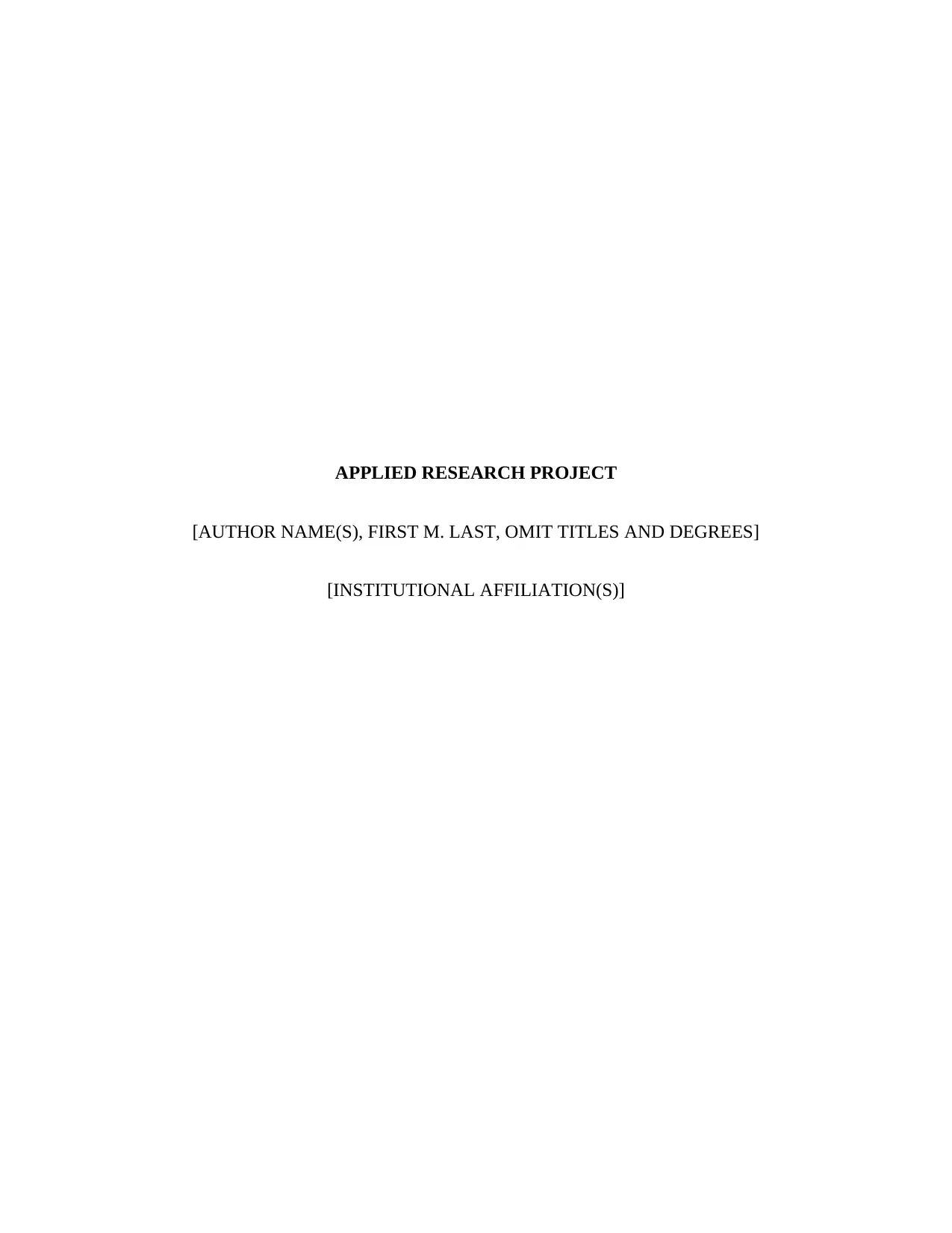
APPLIED RESEARCH PROJECT
[AUTHOR NAME(S), FIRST M. LAST, OMIT TITLES AND DEGREES]
[INSTITUTIONAL AFFILIATION(S)]
[AUTHOR NAME(S), FIRST M. LAST, OMIT TITLES AND DEGREES]
[INSTITUTIONAL AFFILIATION(S)]
Paraphrase This Document
Need a fresh take? Get an instant paraphrase of this document with our AI Paraphraser

Contents
List Figures...............................................................................................................................................2
List of Tables............................................................................................................................................2
ABSTRACT....................................................................................................................................................3
INTRODUCTION...........................................................................................................................................4
Study Area...........................................................................................................................................6
METHODOLOGY...........................................................................................................................................6
RESULTS AND DISCUSSIONS......................................................................................................................21
CONCLUSION.............................................................................................................................................25
REFERENCES..............................................................................................................................................26
List Figures
Figure 1: Process of Textile manufacturing.
List of Tables
Table 1: Summary of the contributions of scholars towards the topic of study.
List Figures...............................................................................................................................................2
List of Tables............................................................................................................................................2
ABSTRACT....................................................................................................................................................3
INTRODUCTION...........................................................................................................................................4
Study Area...........................................................................................................................................6
METHODOLOGY...........................................................................................................................................6
RESULTS AND DISCUSSIONS......................................................................................................................21
CONCLUSION.............................................................................................................................................25
REFERENCES..............................................................................................................................................26
List Figures
Figure 1: Process of Textile manufacturing.
List of Tables
Table 1: Summary of the contributions of scholars towards the topic of study.
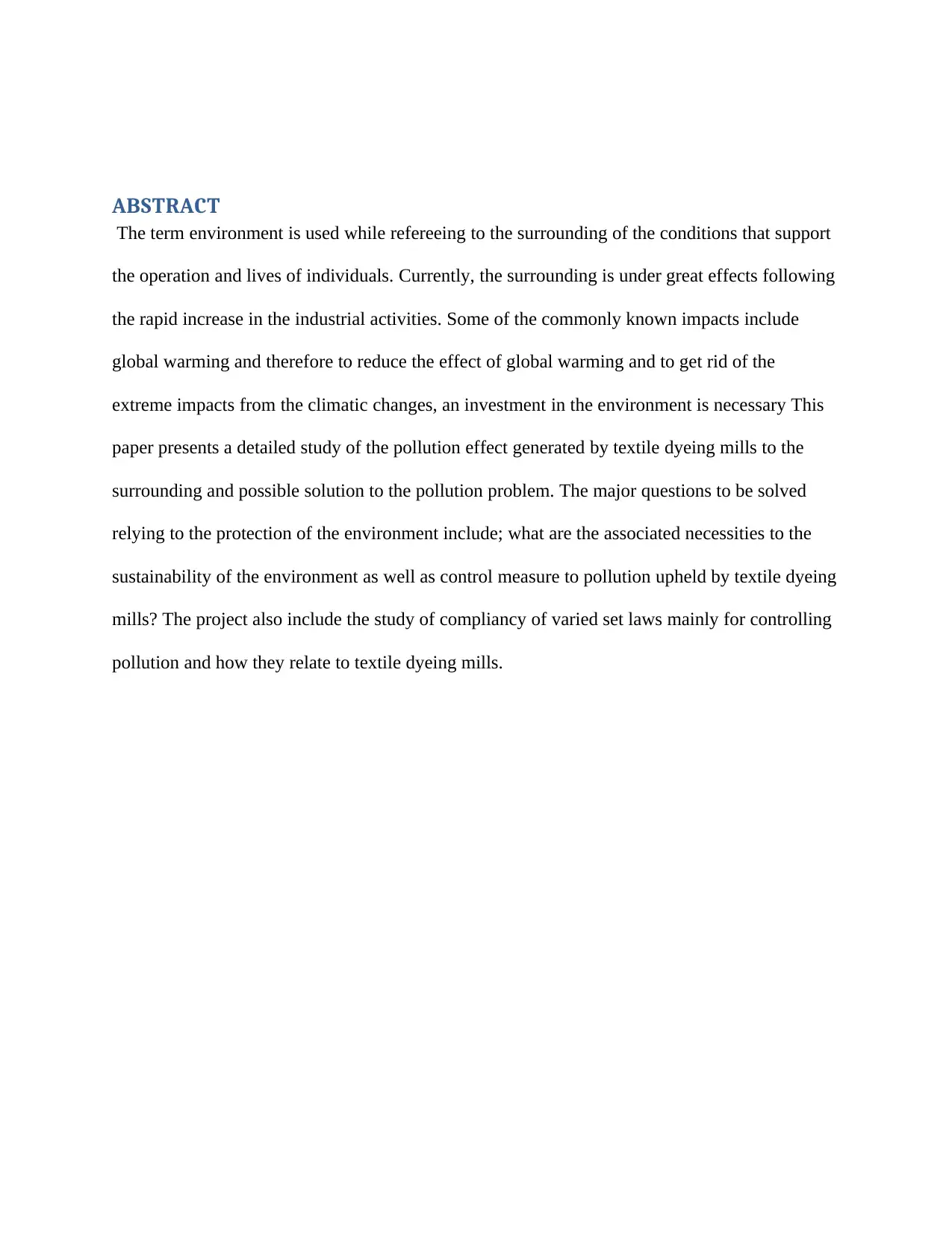
ABSTRACT
The term environment is used while refereeing to the surrounding of the conditions that support
the operation and lives of individuals. Currently, the surrounding is under great effects following
the rapid increase in the industrial activities. Some of the commonly known impacts include
global warming and therefore to reduce the effect of global warming and to get rid of the
extreme impacts from the climatic changes, an investment in the environment is necessary This
paper presents a detailed study of the pollution effect generated by textile dyeing mills to the
surrounding and possible solution to the pollution problem. The major questions to be solved
relying to the protection of the environment include; what are the associated necessities to the
sustainability of the environment as well as control measure to pollution upheld by textile dyeing
mills? The project also include the study of compliancy of varied set laws mainly for controlling
pollution and how they relate to textile dyeing mills.
The term environment is used while refereeing to the surrounding of the conditions that support
the operation and lives of individuals. Currently, the surrounding is under great effects following
the rapid increase in the industrial activities. Some of the commonly known impacts include
global warming and therefore to reduce the effect of global warming and to get rid of the
extreme impacts from the climatic changes, an investment in the environment is necessary This
paper presents a detailed study of the pollution effect generated by textile dyeing mills to the
surrounding and possible solution to the pollution problem. The major questions to be solved
relying to the protection of the environment include; what are the associated necessities to the
sustainability of the environment as well as control measure to pollution upheld by textile dyeing
mills? The project also include the study of compliancy of varied set laws mainly for controlling
pollution and how they relate to textile dyeing mills.
⊘ This is a preview!⊘
Do you want full access?
Subscribe today to unlock all pages.

Trusted by 1+ million students worldwide

INTRODUCTION
The textile industry is considered to be one of the main industries in India with the contribution
of almost over 4% to the country’s Gross Domestic Product (GDP).. This is equivalent to 20% of
the industrial production and almost 17% of the entire export earnings. In fact it has been
estimated that almost more than 40 million people in India are either directly or indirectly
employed in the industry of textile and clothing. This is almost close to the sector of the
agriculture. Textile industry in India has been regarded as the largest generator of the
employment (Chu 2016). Considering that the latest policy of textile focuses on the
maximization of the available resources as well as modernization with the intention to achieve a
lot in terms of being competitive in the economic sector, the sector will definitely experience
some shift in the pattern of the development. The ratio of textile to clothing had been maintained
at 50:50. However, this particular ratio is expected to change to 40:60 in the next 5 years to
come.
The textile industry is considered to be one of the main industries in India with the contribution
of almost over 4% to the country’s Gross Domestic Product (GDP).. This is equivalent to 20% of
the industrial production and almost 17% of the entire export earnings. In fact it has been
estimated that almost more than 40 million people in India are either directly or indirectly
employed in the industry of textile and clothing. This is almost close to the sector of the
agriculture. Textile industry in India has been regarded as the largest generator of the
employment (Chu 2016). Considering that the latest policy of textile focuses on the
maximization of the available resources as well as modernization with the intention to achieve a
lot in terms of being competitive in the economic sector, the sector will definitely experience
some shift in the pattern of the development. The ratio of textile to clothing had been maintained
at 50:50. However, this particular ratio is expected to change to 40:60 in the next 5 years to
come.
Paraphrase This Document
Need a fresh take? Get an instant paraphrase of this document with our AI Paraphraser
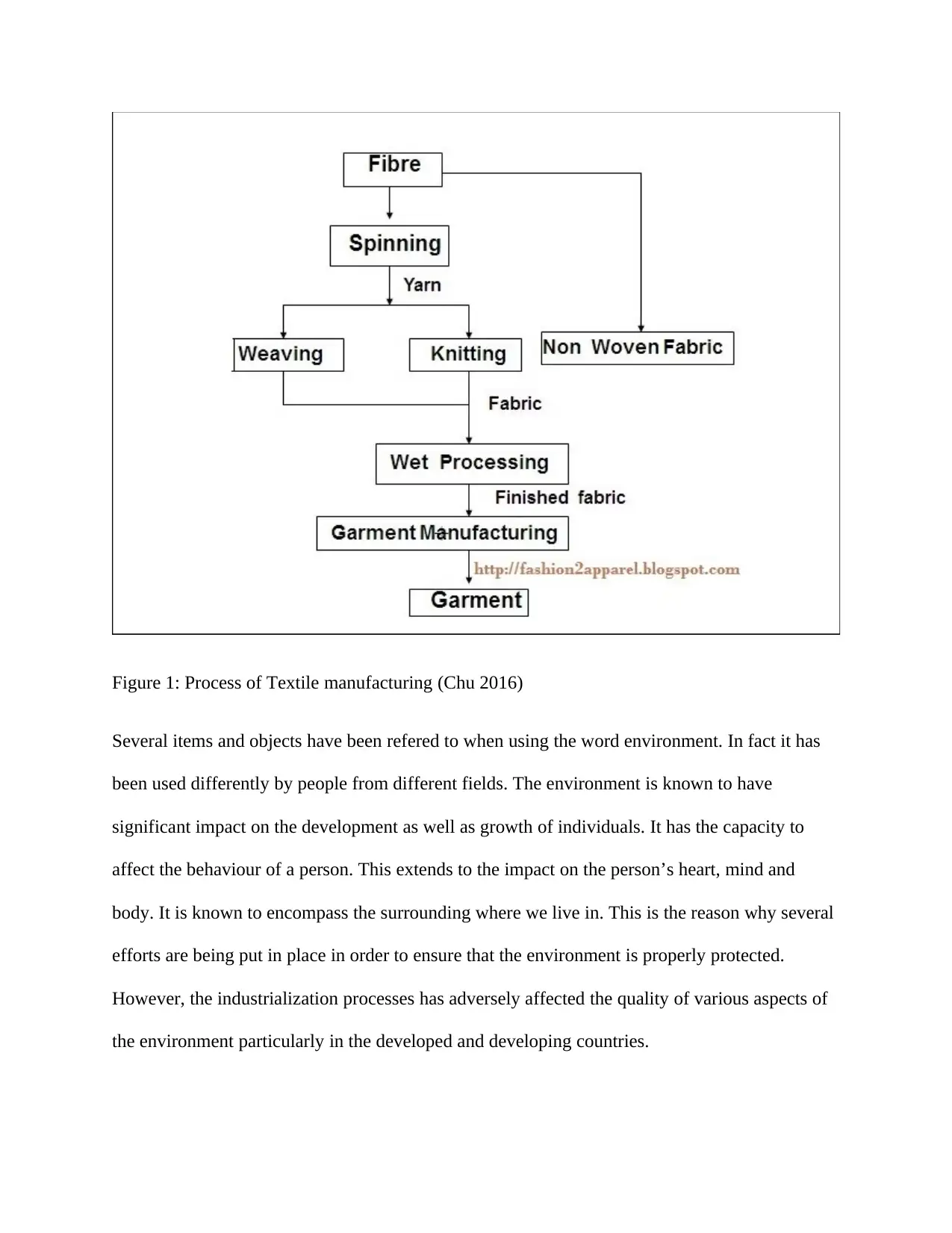
Figure 1: Process of Textile manufacturing (Chu 2016)
Several items and objects have been refered to when using the word environment. In fact it has
been used differently by people from different fields. The environment is known to have
significant impact on the development as well as growth of individuals. It has the capacity to
affect the behaviour of a person. This extends to the impact on the person’s heart, mind and
body. It is known to encompass the surrounding where we live in. This is the reason why several
efforts are being put in place in order to ensure that the environment is properly protected.
However, the industrialization processes has adversely affected the quality of various aspects of
the environment particularly in the developed and developing countries.
Several items and objects have been refered to when using the word environment. In fact it has
been used differently by people from different fields. The environment is known to have
significant impact on the development as well as growth of individuals. It has the capacity to
affect the behaviour of a person. This extends to the impact on the person’s heart, mind and
body. It is known to encompass the surrounding where we live in. This is the reason why several
efforts are being put in place in order to ensure that the environment is properly protected.
However, the industrialization processes has adversely affected the quality of various aspects of
the environment particularly in the developed and developing countries.
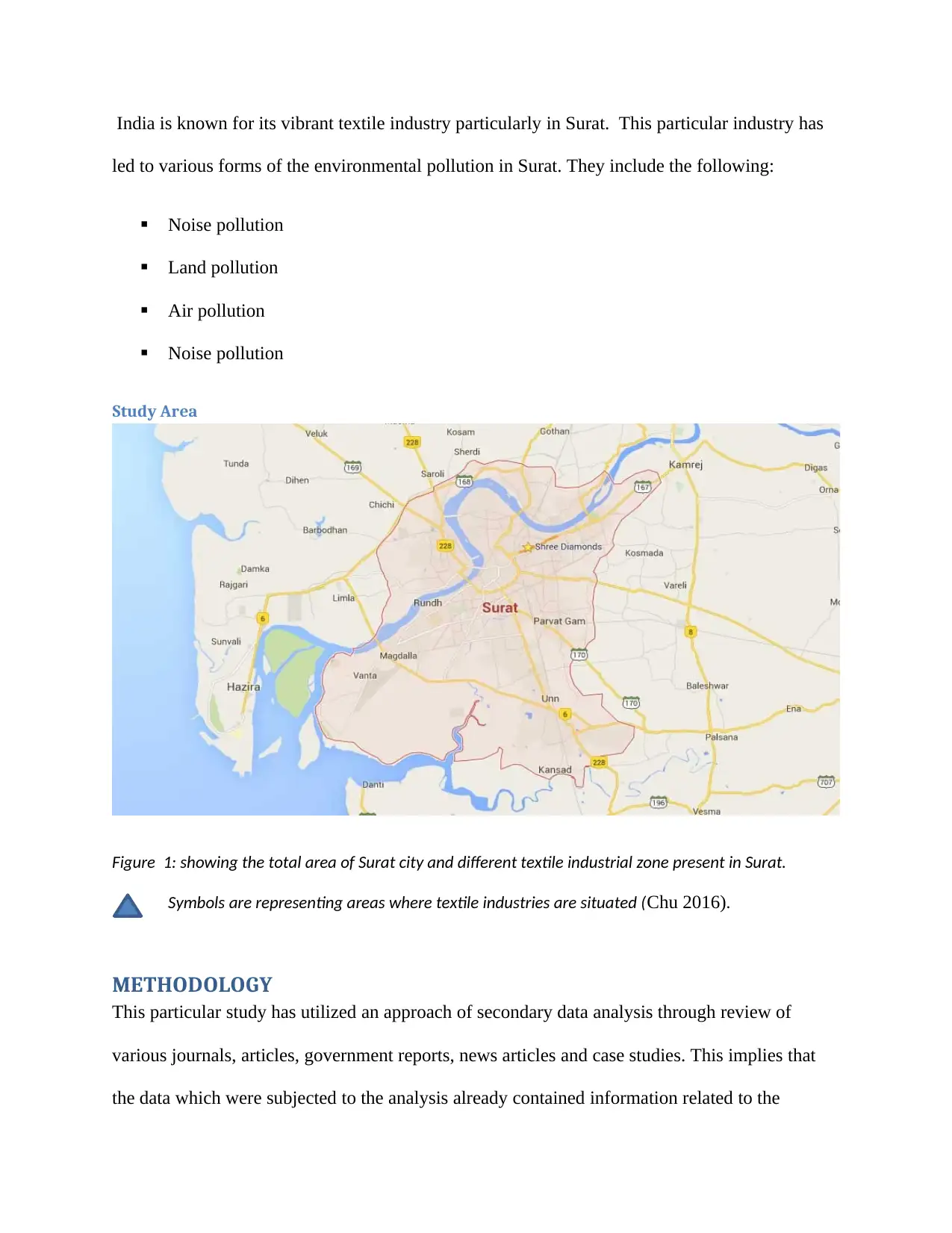
India is known for its vibrant textile industry particularly in Surat. This particular industry has
led to various forms of the environmental pollution in Surat. They include the following:
Noise pollution
Land pollution
Air pollution
Noise pollution
Study Area
Figure 1: showing the total area of Surat city and different textile industrial zone present in Surat.
Symbols are representing areas where textile industries are situated (Chu 2016).
METHODOLOGY
This particular study has utilized an approach of secondary data analysis through review of
various journals, articles, government reports, news articles and case studies. This implies that
the data which were subjected to the analysis already contained information related to the
led to various forms of the environmental pollution in Surat. They include the following:
Noise pollution
Land pollution
Air pollution
Noise pollution
Study Area
Figure 1: showing the total area of Surat city and different textile industrial zone present in Surat.
Symbols are representing areas where textile industries are situated (Chu 2016).
METHODOLOGY
This particular study has utilized an approach of secondary data analysis through review of
various journals, articles, government reports, news articles and case studies. This implies that
the data which were subjected to the analysis already contained information related to the
⊘ This is a preview!⊘
Do you want full access?
Subscribe today to unlock all pages.

Trusted by 1+ million students worldwide
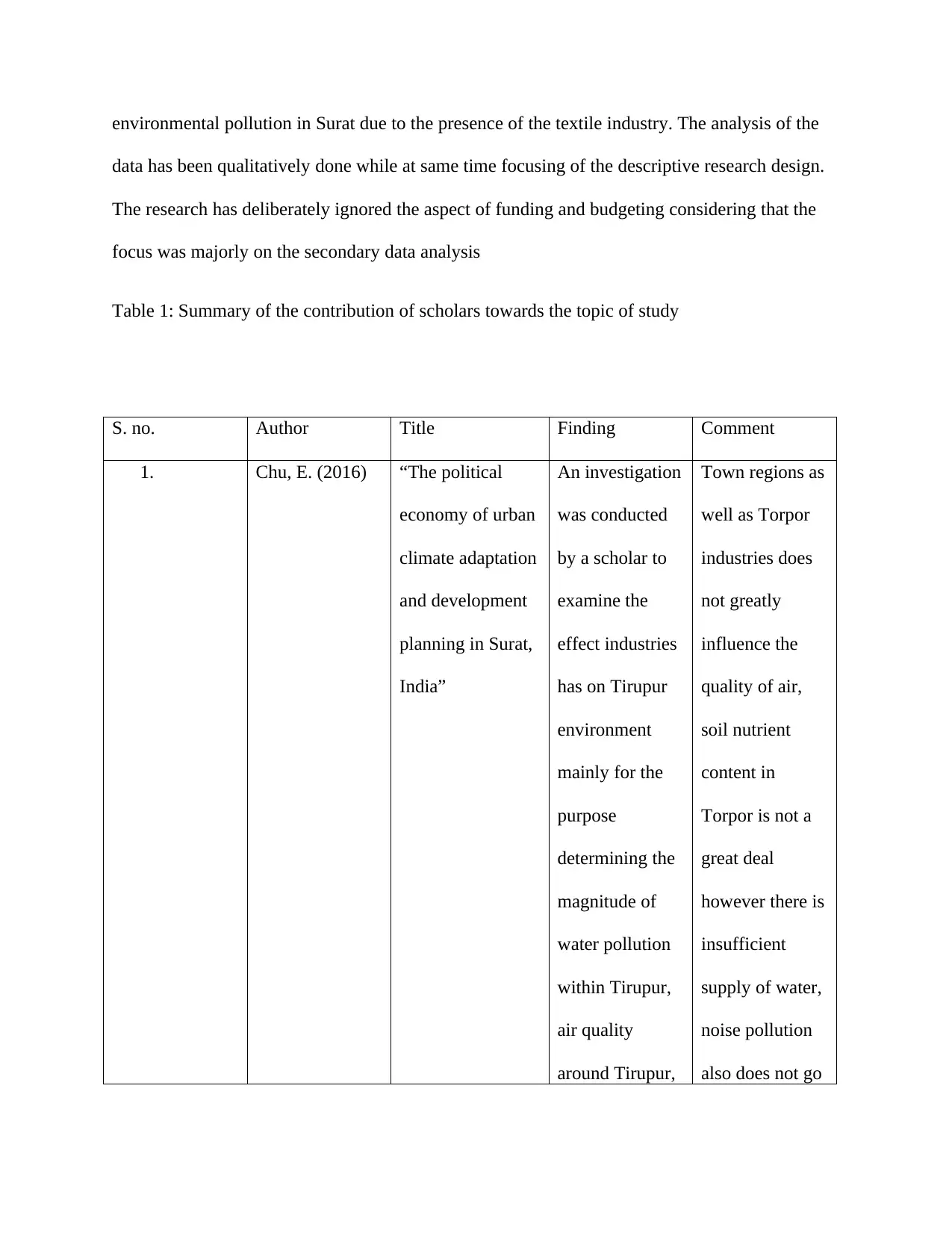
environmental pollution in Surat due to the presence of the textile industry. The analysis of the
data has been qualitatively done while at same time focusing of the descriptive research design.
The research has deliberately ignored the aspect of funding and budgeting considering that the
focus was majorly on the secondary data analysis
Table 1: Summary of the contribution of scholars towards the topic of study
S. no. Author Title Finding Comment
1. Chu, E. (2016) “The political
economy of urban
climate adaptation
and development
planning in Surat,
India”
An investigation
was conducted
by a scholar to
examine the
effect industries
has on Tirupur
environment
mainly for the
purpose
determining the
magnitude of
water pollution
within Tirupur,
air quality
around Tirupur,
Town regions as
well as Torpor
industries does
not greatly
influence the
quality of air,
soil nutrient
content in
Torpor is not a
great deal
however there is
insufficient
supply of water,
noise pollution
also does not go
data has been qualitatively done while at same time focusing of the descriptive research design.
The research has deliberately ignored the aspect of funding and budgeting considering that the
focus was majorly on the secondary data analysis
Table 1: Summary of the contribution of scholars towards the topic of study
S. no. Author Title Finding Comment
1. Chu, E. (2016) “The political
economy of urban
climate adaptation
and development
planning in Surat,
India”
An investigation
was conducted
by a scholar to
examine the
effect industries
has on Tirupur
environment
mainly for the
purpose
determining the
magnitude of
water pollution
within Tirupur,
air quality
around Tirupur,
Town regions as
well as Torpor
industries does
not greatly
influence the
quality of air,
soil nutrient
content in
Torpor is not a
great deal
however there is
insufficient
supply of water,
noise pollution
also does not go
Paraphrase This Document
Need a fresh take? Get an instant paraphrase of this document with our AI Paraphraser
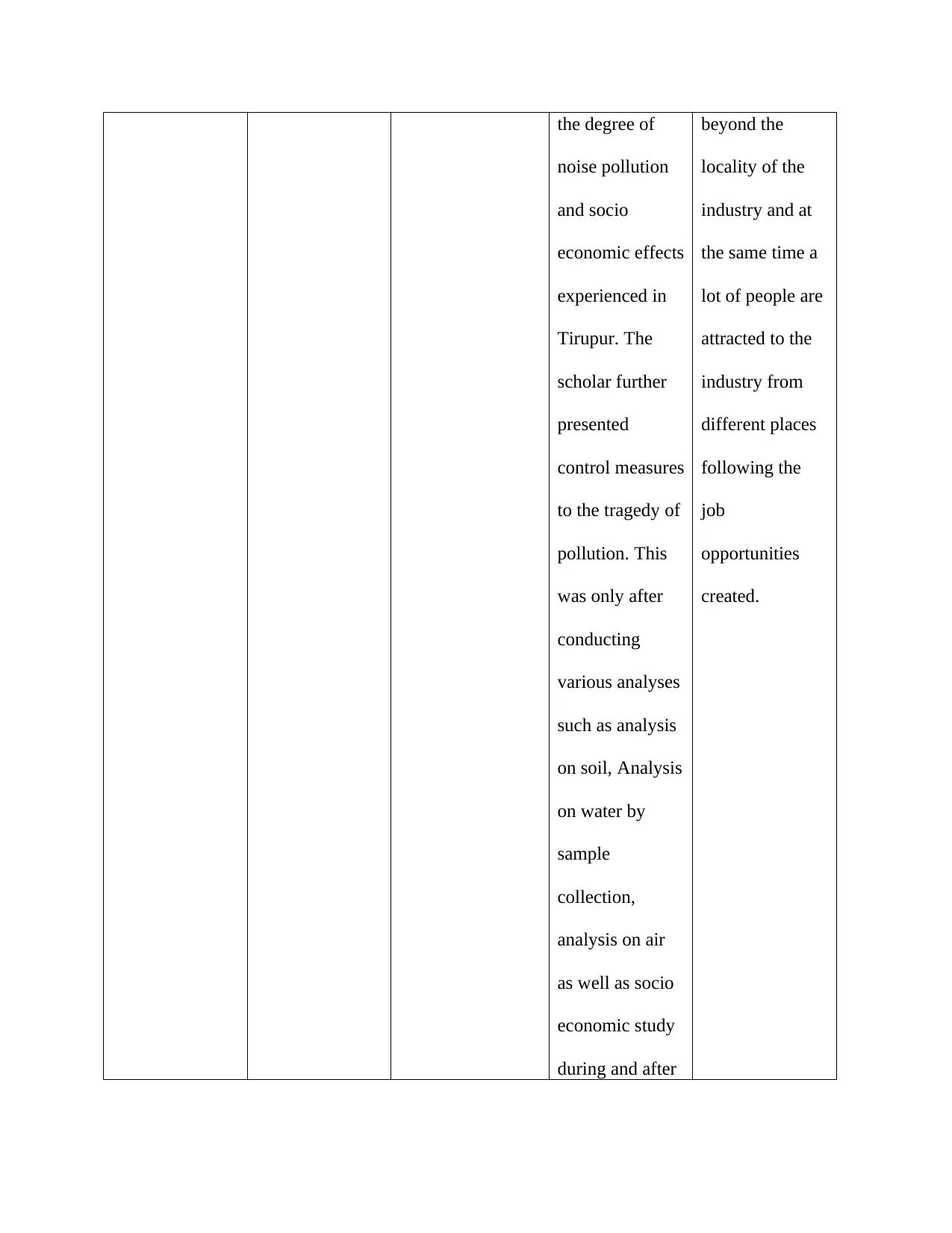
the degree of
noise pollution
and socio
economic effects
experienced in
Tirupur. The
scholar further
presented
control measures
to the tragedy of
pollution. This
was only after
conducting
various analyses
such as analysis
on soil, Analysis
on water by
sample
collection,
analysis on air
as well as socio
economic study
during and after
beyond the
locality of the
industry and at
the same time a
lot of people are
attracted to the
industry from
different places
following the
job
opportunities
created.
noise pollution
and socio
economic effects
experienced in
Tirupur. The
scholar further
presented
control measures
to the tragedy of
pollution. This
was only after
conducting
various analyses
such as analysis
on soil, Analysis
on water by
sample
collection,
analysis on air
as well as socio
economic study
during and after
beyond the
locality of the
industry and at
the same time a
lot of people are
attracted to the
industry from
different places
following the
job
opportunities
created.
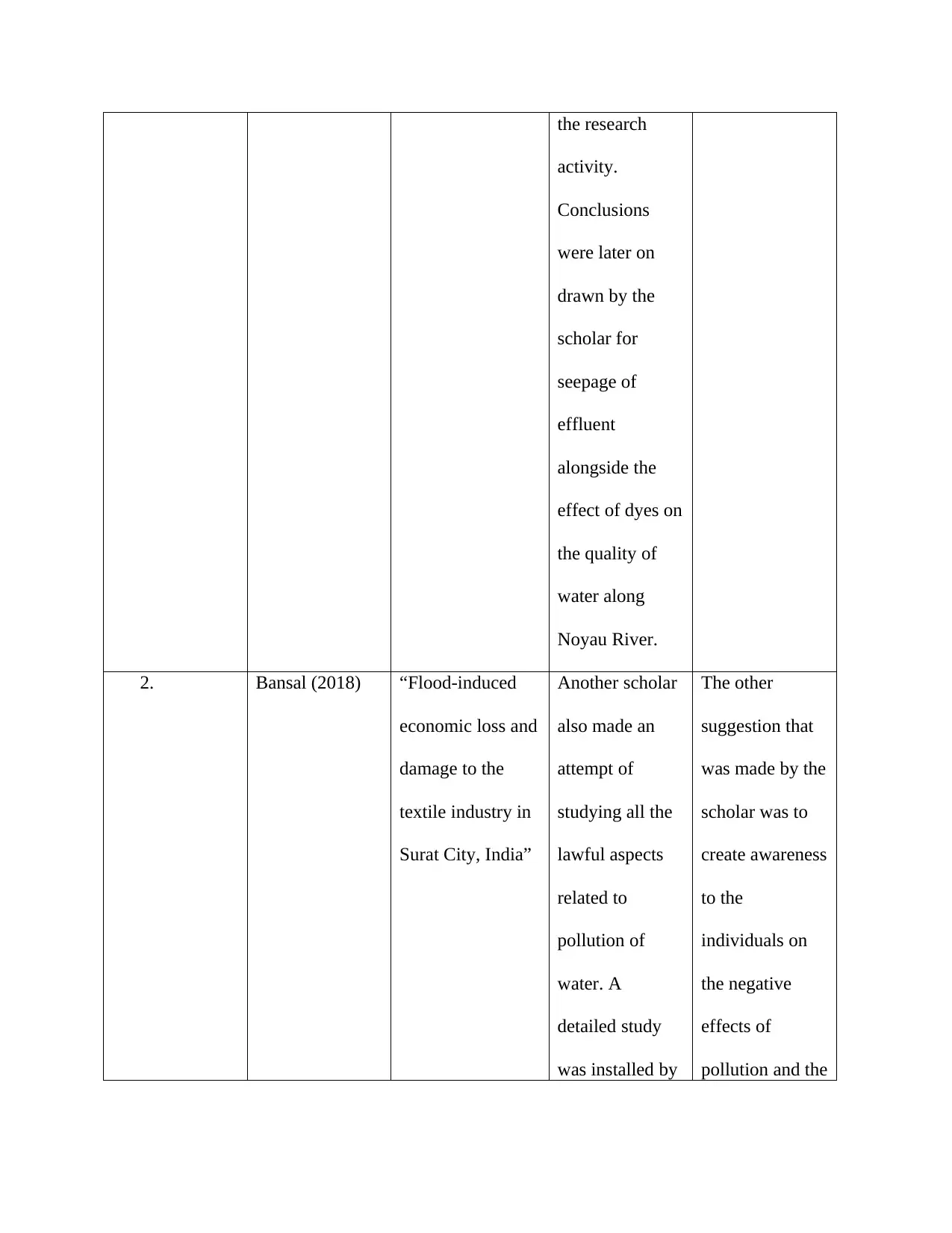
the research
activity.
Conclusions
were later on
drawn by the
scholar for
seepage of
effluent
alongside the
effect of dyes on
the quality of
water along
Noyau River.
2. Bansal (2018) “Flood-induced
economic loss and
damage to the
textile industry in
Surat City, India”
Another scholar
also made an
attempt of
studying all the
lawful aspects
related to
pollution of
water. A
detailed study
was installed by
The other
suggestion that
was made by the
scholar was to
create awareness
to the
individuals on
the negative
effects of
pollution and the
activity.
Conclusions
were later on
drawn by the
scholar for
seepage of
effluent
alongside the
effect of dyes on
the quality of
water along
Noyau River.
2. Bansal (2018) “Flood-induced
economic loss and
damage to the
textile industry in
Surat City, India”
Another scholar
also made an
attempt of
studying all the
lawful aspects
related to
pollution of
water. A
detailed study
was installed by
The other
suggestion that
was made by the
scholar was to
create awareness
to the
individuals on
the negative
effects of
pollution and the
⊘ This is a preview!⊘
Do you want full access?
Subscribe today to unlock all pages.

Trusted by 1+ million students worldwide
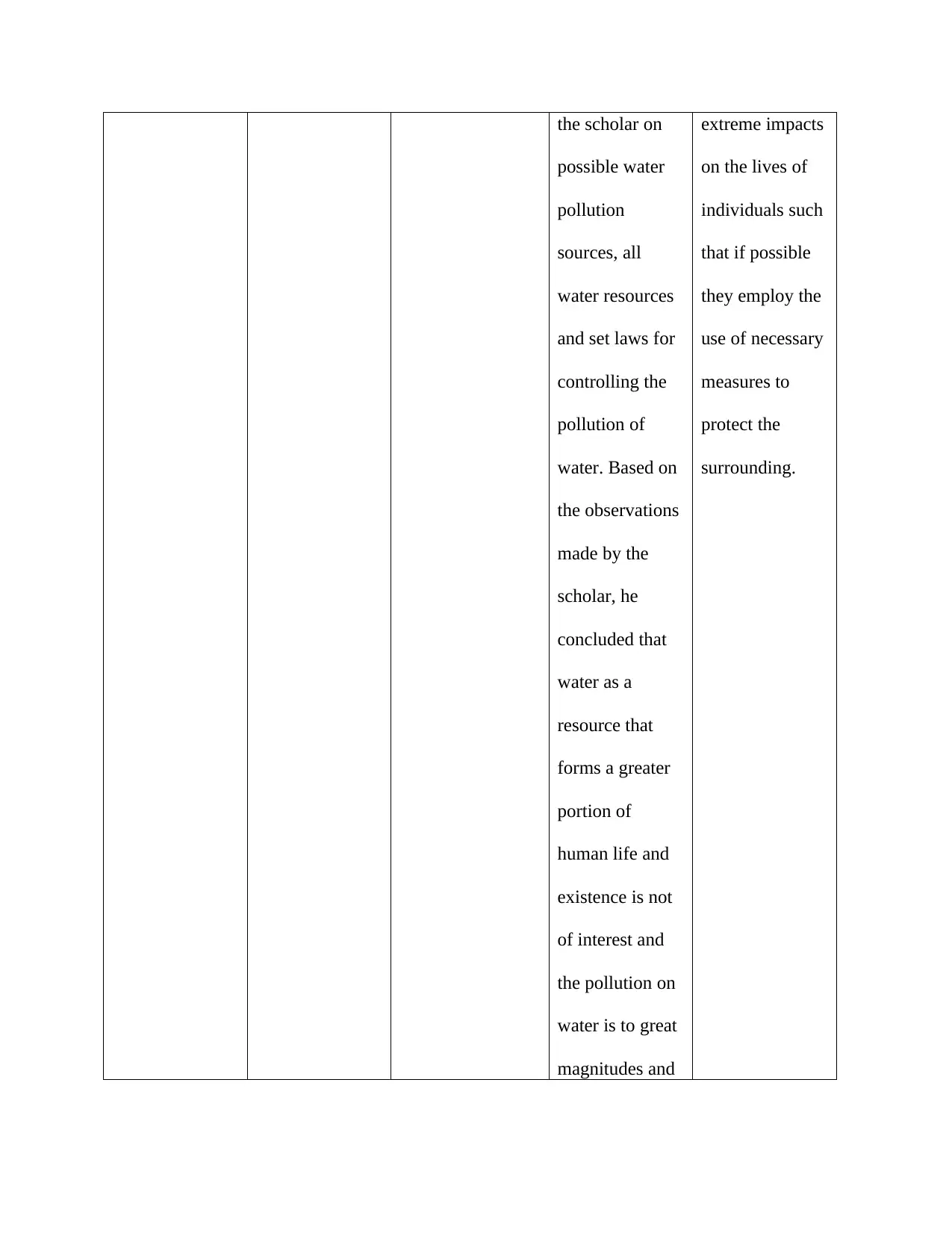
the scholar on
possible water
pollution
sources, all
water resources
and set laws for
controlling the
pollution of
water. Based on
the observations
made by the
scholar, he
concluded that
water as a
resource that
forms a greater
portion of
human life and
existence is not
of interest and
the pollution on
water is to great
magnitudes and
extreme impacts
on the lives of
individuals such
that if possible
they employ the
use of necessary
measures to
protect the
surrounding.
possible water
pollution
sources, all
water resources
and set laws for
controlling the
pollution of
water. Based on
the observations
made by the
scholar, he
concluded that
water as a
resource that
forms a greater
portion of
human life and
existence is not
of interest and
the pollution on
water is to great
magnitudes and
extreme impacts
on the lives of
individuals such
that if possible
they employ the
use of necessary
measures to
protect the
surrounding.
Paraphrase This Document
Need a fresh take? Get an instant paraphrase of this document with our AI Paraphraser
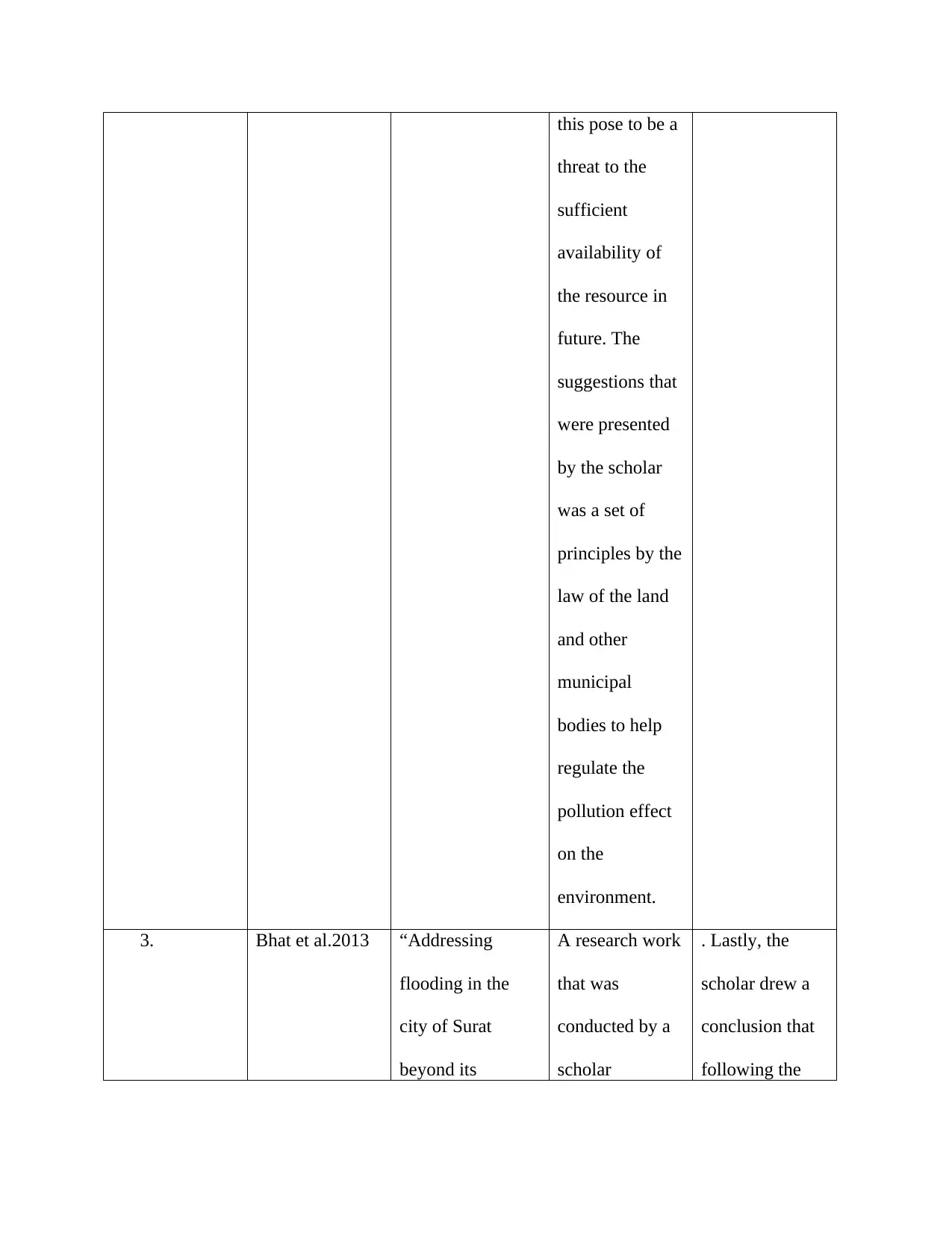
this pose to be a
threat to the
sufficient
availability of
the resource in
future. The
suggestions that
were presented
by the scholar
was a set of
principles by the
law of the land
and other
municipal
bodies to help
regulate the
pollution effect
on the
environment.
3. Bhat et al.2013 “Addressing
flooding in the
city of Surat
beyond its
A research work
that was
conducted by a
scholar
. Lastly, the
scholar drew a
conclusion that
following the
threat to the
sufficient
availability of
the resource in
future. The
suggestions that
were presented
by the scholar
was a set of
principles by the
law of the land
and other
municipal
bodies to help
regulate the
pollution effect
on the
environment.
3. Bhat et al.2013 “Addressing
flooding in the
city of Surat
beyond its
A research work
that was
conducted by a
scholar
. Lastly, the
scholar drew a
conclusion that
following the
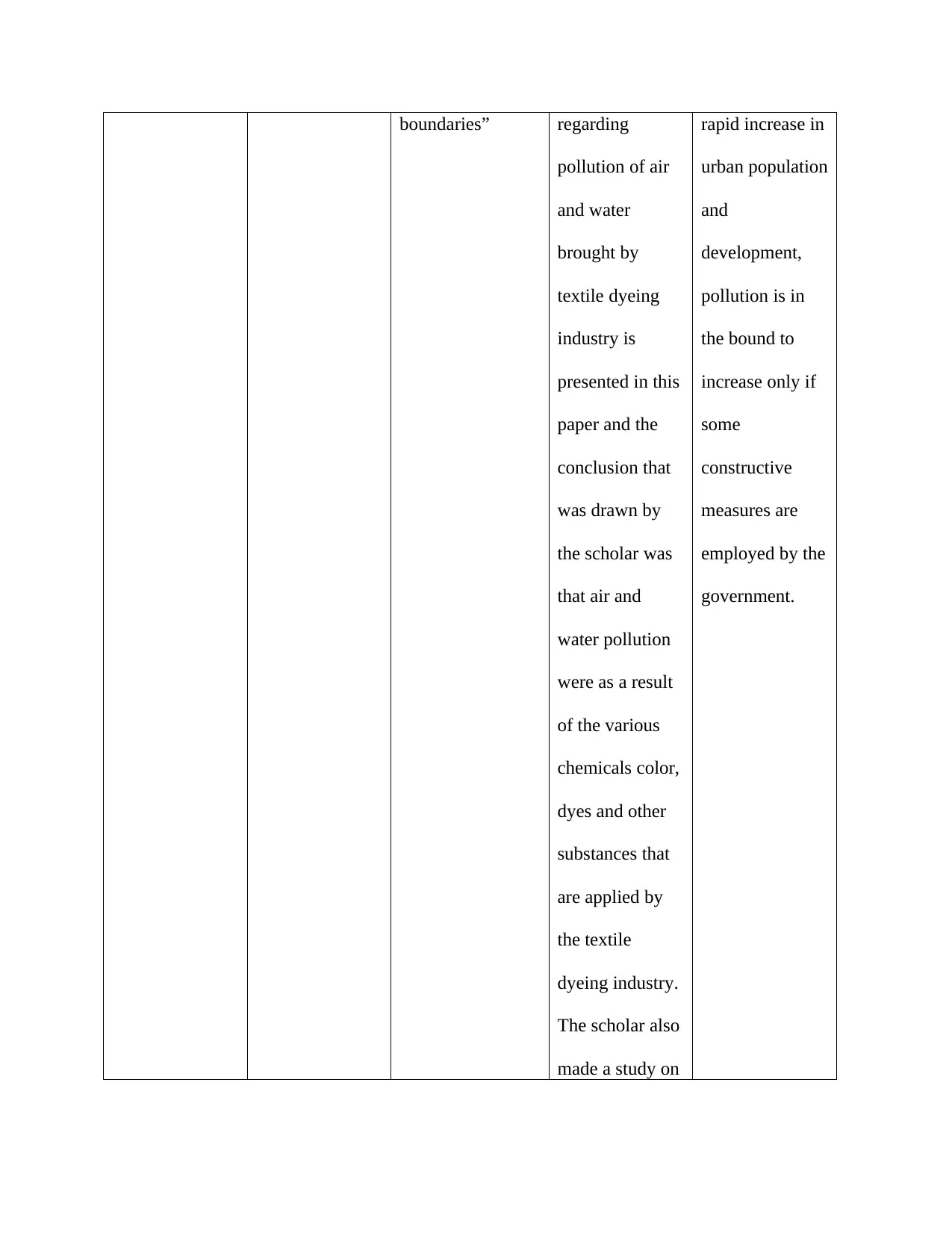
boundaries” regarding
pollution of air
and water
brought by
textile dyeing
industry is
presented in this
paper and the
conclusion that
was drawn by
the scholar was
that air and
water pollution
were as a result
of the various
chemicals color,
dyes and other
substances that
are applied by
the textile
dyeing industry.
The scholar also
made a study on
rapid increase in
urban population
and
development,
pollution is in
the bound to
increase only if
some
constructive
measures are
employed by the
government.
pollution of air
and water
brought by
textile dyeing
industry is
presented in this
paper and the
conclusion that
was drawn by
the scholar was
that air and
water pollution
were as a result
of the various
chemicals color,
dyes and other
substances that
are applied by
the textile
dyeing industry.
The scholar also
made a study on
rapid increase in
urban population
and
development,
pollution is in
the bound to
increase only if
some
constructive
measures are
employed by the
government.
⊘ This is a preview!⊘
Do you want full access?
Subscribe today to unlock all pages.

Trusted by 1+ million students worldwide
1 out of 28
Your All-in-One AI-Powered Toolkit for Academic Success.
+13062052269
info@desklib.com
Available 24*7 on WhatsApp / Email
![[object Object]](/_next/static/media/star-bottom.7253800d.svg)
Unlock your academic potential
Copyright © 2020–2025 A2Z Services. All Rights Reserved. Developed and managed by ZUCOL.

